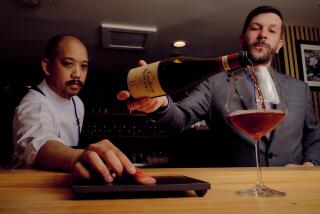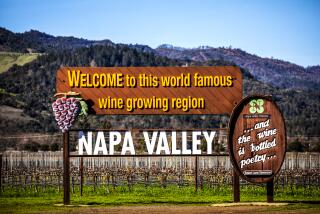Let’s Make One Thing Perfectly Unclear
Americans have a fixation on the appearance of wine. For instance, we believe a white wine must be crystal clear. The more academically minded of us even mark a wine down as flawed if it has the least bit of haziness.
It is for this reason alone that winemakers throughout California shoulder their white wines through filters, fine them with gelatin and then ram them through chilling machines. It’s all to make them sparkling clear.
So it was with no small degree of surprise, and much delight, that I discovered a nearly unhandled Chardonnay the other day. The 1990 Newton Vineyard Chardonnay “Unfiltered” ($19) was made to resemble French white Burgundy, and the attempt works strikingly well.
Newton winemaker John Kongsgaard says he has long felt the best white wines of France were made with an eye on aroma and flavor, not appearance. “The best Burgundies,” Kongsgaard says, “like those of Bonneau du Martray, are not entirely clear, and that’s due to the long time they spend in the barrel and the fact that they are not filtered.”
White Burgundy is the standard to which many Chardonnays aspire. These are wines of richness and depth that win people over by their complexity, not their fruit. California Chardonnays, on the other hand, typically offer more tropical fruit character--akin to pineapple, pear, guava and coconut.
Kongsgaard says the faint hazelnut aroma and subtler nuances in his 1990 Chardonnay are the result of a decision to make a wine that truly had the look of Burgundy. He was prepared to sacrifice a bit of fruit for depth and richness.
A number of Santa Barbara County wineries have taken similar approaches to making Chardonnay, specifically Au Bon Climat’s Jim Clendenen and Babcock Vineyard’s Brian Babcock, whose reserve bottlings have been well received. Ken Deis at Flora Springs has done similar things with his Chardonnay by aging it on the lees--the spent yeast cells. And since 1986 at Franciscan Vineyards, Greg Upton has made a stylish Chardonnay called “Cuvee Sauvage,” using only wild yeasts to ferment, aging the wine 15 months in barrels, then using light fining agents to clarify the wine, but not filter it. The 1990 version ($22) has a butter-rum-and-vanilla character and is quite soft.
The major difference between the Newton “Unfiltered” and the rest of these wines is one of degree. While other Chardonnays are made with little filtering or fining, Newton eliminates it completely. And no other wine in California ages as long in barrel--fully 18 months.
As has become the custom at many wineries, Kongsgaard fermented the wine in barrel--but he used a variety of yeasts, including those naturally occurring in the vineyard. He also kept the temperature of fermentation as cool as possible. The combination of yeasts and cold kept the fermentation process poking along for months, rather than the usual few weeks.
Then the wine went through a second (malolactic) fermentation, converting its sharp malic acid (think of apples) into weaker lactic acid (think of milk). Normally, malolactic fermentations take just a few weeks; Newton’s lasted six months.
This technique of keeping the malolactic fermentation going for months isn’t new. John Williams at Frog’s Leap Winery used it with his just-released 1991 Chardonnay ($16). Newton, however, went beyond that by leaving the Chardonnay in barrels on the yeast lees for a full 10 months, gaining added complexity while sacrificing more fruit.
Then the wine was transferred to older barrels to rest untouched for another eight months. Treating the wine this way protects it against later oxidation. (The bottle I tasted was actually just as good two days later as it was when I opened it.)
Finally, before bottling the wine, Kongsgaard eliminated two procedures that he feels can strip a wine of character: He did not filter it (meaning it might have a slightly less-than-brilliant appearance), and he did not “cold-stabilize” the wine, to prevent the formation of tartrate crystals when the wine is chilled.
As a result, the wine has a faint haze and, if chilled in a 40-degree refrigerator for hours, may show some harmless tartrate crystals on the cork. Winemakers who attended classical enology schools are taught to avoid these appearance flaws, but Kongsgaard is not worried.
The wine actually reminds me--if not in character then certainly in style--of precisely the wine Kongsgaard mentioned, the Corton-Charlemagne from Bonneau du Martray.
“This started out as a brave experiment, sure,” he says, “but we’ve been able to repeat the results in 1991, so we feel confident that we have a winning technique.”
The nice thing is that Newton made some 2,000 cases of this wine: a bold experiment, the result of which may not be perfectly clear, but which will prove itself at the dinner table.
Wine of the Week
1991 Columbia Crest Semillon-Chardonnay ($6)-- In Australia, blending these two grape varieties is not uncommon, and in California’s Sonoma County, Geyser Peak Winery has made an excellent wine since 1989 called Semchard. This version, from Washington state, shows a delicate hay aroma from the Semillon and citrus from the Chardonnay, with the rich texture of the latter and the crisp aftertaste of the former. Not much oak here; the wine relies on fruit. It is occasionally seen discounted below $5.
More to Read
Eat your way across L.A.
Get our weekly Tasting Notes newsletter for reviews, news and more.
You may occasionally receive promotional content from the Los Angeles Times.









